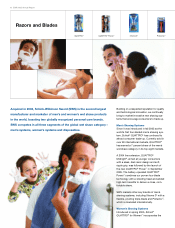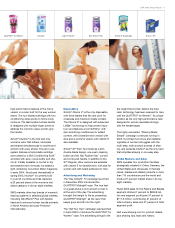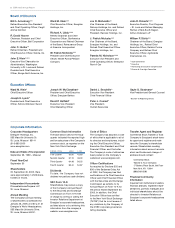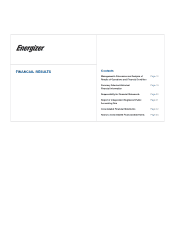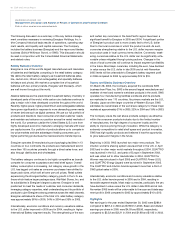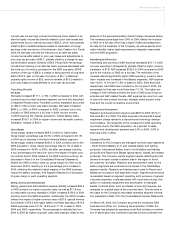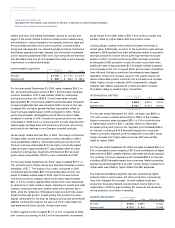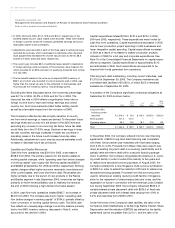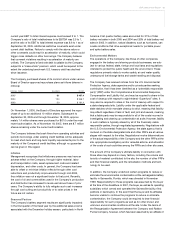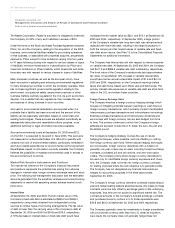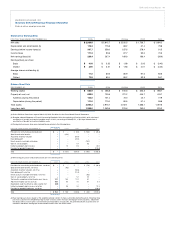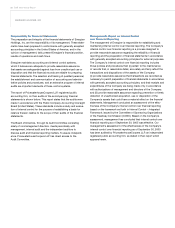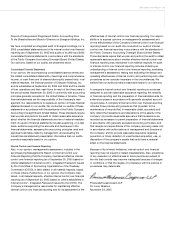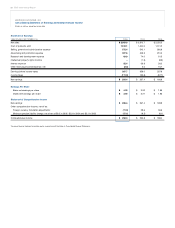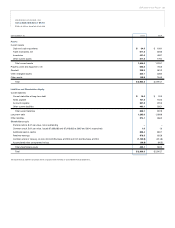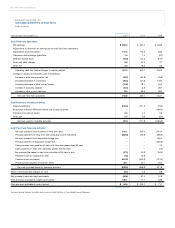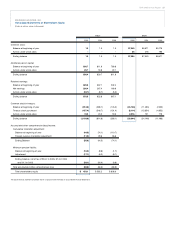Energizer 2005 Annual Report Download - page 18
Download and view the complete annual report
Please find page 18 of the 2005 Energizer annual report below. You can navigate through the pages in the report by either clicking on the pages listed below, or by using the keyword search tool below to find specific information within the annual report.
16 ENR 2005 Annual Report
The Nestle Corporation, Ralston’s successor is obligated to indemnify
the Company for 50% of any such liabilities in excess of $3.0.
Under the terms of the Stock and Asset Purchase Agreement between
Pfizer, Inc. and the Company, relating to the acquisition of the SWS
business, environmental liabilities related to pre-closing operations
of that business, or associated with properties acquired, are generally
retained by Pfizer subject to time limitations varying from two years
to 10 years following closing with respect to various classes or types
of liabilities, minimum thresholds for indemnification by Pfizer and
maximum limitations on Pfizer’s liability, which thresholds and limita-
tions also vary with respect to various classes or types of liabilities.
Many European countries, as well as the European Union, have
been very active in adopting and enforcing environmental regulations.
In many developing countries in which the Company operates, there
has not been significant governmental regulation relating to the
environment, occupational safety, employment practices or other
business matters routinely regulated in the U.S. As such economies
develop, it is possible that new regulations may increase the risk
and expense of doing business in such countries.
Accruals for environmental remediation are recorded when it is
probable that a liability has been incurred and the amount of the
liability can be reasonably estimated, based on current law and
existing technologies. These accruals are adjusted periodically as
assessments take place and remediation efforts progress, or as
additional technical or legal information becomes available.
Accrued environmental costs at September 30, 2005 were $7.2,
of which $1.1 is expected to be spent in fiscal 2006. This accrual is
not measured on a discounted basis. It is difficult to quantify with
certainty the cost of environmental matters, particularly remediation
and future capital expenditures for environmental control equipment.
Nevertheless, based on information currently available, the Company
believes the possibility of material environmental costs in excess of
the accrued amount is remote.
Market Risk Sensitive Instruments and Positions
The market risk inherent in the Company’s financial instruments
and positions represents the potential loss arising from adverse
changes in interest rates, foreign currency exchange rates and stock
price. The following risk management discussion and the estimated
amounts generated from the sensitivity analyses are forward-looking
statements of market risk assuming certain adverse market condi-
tions occur.
Interest Rates
At September 30, 2005 and 2004, the fair market value of the
Company’sfixed-rate debt is estimated at $965.2 and $358.4,
respectively, using yields obtained from independent pricing
sources for similar types of borrowing arrangements. The fair value
of debt is lower than the carrying value of the Company’s debt at
September 30, 2005 and 2004 by $34.8 and $16.6, respectively.
A10% decrease in interest rates on fixed-rate debt would have
increased the fair market value by $30.1 and $12.1 at September 30,
2005 and 2004, respectively. In September 2005, a large portion
of the Company’s variable-rate long-term debt was refinanced and
replaced with fixed-rate debt, resulting in the large fluctuations in
both the carrying and fair market values of variable-rate and fixed-
rate debt shown above. See Note 12 to the Consolidated Financial
Statements for additional information.
The Company has interest rate risk with respect to interest expense
on variable-rate debt. At September 30, 2005 and 2004, the Company
had $411.2 and $866.9 variable-rate debt outstanding, respectively.
The book value of the Company’s variable-rate debt approximates
fair value. A hypothetical 10% increase in variable interest rates
would have had an annual unfavorable impact of $1.9 and $2.4 in
2005 and 2004, respectively, on the Company’s earnings before
taxes and cash flows, based upon these year-end debt levels. The
primary interest rate exposures on variable-rate debt are short-term
rates in the U.S. and certain Asian countries.
Foreign Currency Exchange Rates
The Company employs a foreign currency hedging strategy which
focuses on mitigating potential losses in earnings or cash flows on
foreign currency transactions, which primarily consist of anticipated
intercompany purchase transactions and intercompany borrowings.
External purchase transactions and intercompany dividends and
service fees with foreign currency risk are also hedged from time
to time. The primarycurrencies to which the Company’s foreign
affiliates are exposed include the U.S. dollar, the euro, the yen and
the British pound.
The Company’s hedging strategy involves the use of natural
hedging techniques, wherepossible, such as offsetting or netting
like foreign currency cash flows. Where natural hedging techniques
are not possible, foreign currency derivatives with a duration of
generally one year or less may be used, including forward exchange
contracts, purchased put and call options, and zero-cost option
collars. The Company policy allows foreign currency derivatives to
be used only for identifiable foreign currency exposures and, there-
fore, the Company does not enter into foreign currency contracts
for trading purposes where the sole objective is to generate profits.
The Company has not designated any financial instruments as
hedges for accounting purposes in the three years ended
September 30, 2005.
The Company’sforeign currency derivative contracts outstanding at
year-end hedge existing balance sheet exposures. Any losses on these
contracts would be fully offset by exchange gains on the underlying
exposures, thus they arenot subject to significant market risk. The
contractual amounts of the Company’s forward exchange contracts
and purchased currency options in U.S. dollar equivalents were
$30.8 and $43.2 at September 30, 2005 and 2004 respectively.
The Company generally views its investments in foreign subsidiaries
with a functional currency other than the U.S. dollar as long-term.
As a result, the Company does not generally hedge these net
ENERGIZER HOLDINGS, INC.
Management’s Discussion and Analysis of Results of Operations and Financial Condition
(Dollars in millions, except per share and percentage data)


